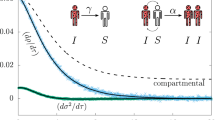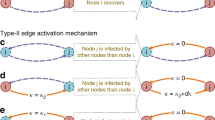Abstract
IN general an epidemic process can be characterized as a time-dependent process of transition by the members of a population, where the state transitions are caused by exposure to some influence called infectious material. The members of the population can belong to one of three basic states at a given point in time: (a) Infective, those members of the population who are host to the infectious material; (b) Susceptible, those members of the population who can become infectives given effective contact with infectious material; (c) Removal, those members of the population who have been removed from circulation for one of a variety of reasons such as death, immunity, hospitalization, etc.
This is a preview of subscription content, access via your institution
Access options
Subscribe to this journal
Receive 51 print issues and online access
$199.00 per year
only $3.90 per issue
Buy this article
- Purchase on Springer Link
- Instant access to full article PDF
Prices may be subject to local taxes which are calculated during checkout
Similar content being viewed by others
References
Bailey, N. T. J., The Mathematical Theory of Epidemics (Griffin, 1960).
Bartlett, M. S., Stochastic Population Models in Ecology and Epidemiology (John Wiley, 1961).
Goffman, W., and Newill, V. A., Nature, 204, 225 (1964).
Hurewicz, W., Lectures on Ordinary Differential Equations (Mass. Inst. Tech. Press, 1958).
Author information
Authors and Affiliations
Rights and permissions
About this article
Cite this article
GOFFMAN, W. An Epidemic Process in an Open Population. Nature 205, 831–832 (1965). https://doi.org/10.1038/205831a0
Issue Date:
DOI: https://doi.org/10.1038/205831a0
This article is cited by
-
A coupled model for government communication and rumor spreading in emergencies
Advances in Difference Equations (2016)
-
Bibliometric models for journal productivity
Social Indicators Research (1977)
-
Stability of Epidemic Processes
Nature (1966)
Comments
By submitting a comment you agree to abide by our Terms and Community Guidelines. If you find something abusive or that does not comply with our terms or guidelines please flag it as inappropriate.



